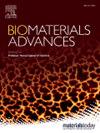负载pd - l1表达外泌体的免疫调节水凝胶重编程巨噬细胞并加速糖尿病伤口愈合
IF 5.5
2区 医学
Q2 MATERIALS SCIENCE, BIOMATERIALS
Materials Science & Engineering C-Materials for Biological Applications
Pub Date : 2025-05-27
DOI:10.1016/j.bioadv.2025.214362
引用次数: 0
摘要
糖尿病足溃疡(DFU)是糖尿病的一种严重并发症,由于截肢和死亡的高风险,目前是全球医疗保健的挑战。本研究开发了一种多功能水凝胶敷料,明胶甲基丙烯酰(GelMA)水凝胶负载白介素-4 (IL-4)工程外泌体(Exos),旨在协同调节免疫反应并促进血管生成,以完全修复糖尿病伤口。通过在NIH3T3成纤维细胞中过表达IL-4,构建了程序性死亡配体1 (PD-L1)富集的Exos。GelMA水凝胶负载IL-4过表达的NIH3T3成纤维细胞衍生的Exos (GelMA/ExosIL-4水凝胶)具有良好的物理化学特性,包括三维多孔微观结构、可注射性、组织粘附性、自愈性和持续的保湿性。体外评估证明了人脐静脉内皮细胞(HUVECs)的生物相容性、持续的外泌体释放、增强的活力、迁移和管状形成。在糖尿病创面模型中,水凝胶显著加速创面愈合,促进再上皮化和血管生成,使巨噬细胞偏向抗炎M2极化,同时抑制t细胞增殖。这些发现强调了GelMA/ExosIL-4水凝胶的双重免疫调节和促血管生成功效,为慢性伤口治疗提供了一种有希望的治疗策略。本文章由计算机程序翻译,如有差异,请以英文原文为准。
Immunomodulatory hydrogel loaded with PD-L1-expressing exosomes reprograms macrophages and accelerates diabetic wound healing
Diabetic foot ulcers (DFU), a severe complication of diabetes mellitus, present a global healthcare challenge due to high risks of limb amputation and mortality. This study developed a multifunctional hydrogel dressing, Gelatin Methacryloyl (GelMA) hydrogel loaded with interleukin-4 (IL-4)-engineered exosomes (Exos), designed to synergistically modulate immune responses and enhance angiogenesis for complete diabetic wound repair. The programmed death-ligand 1 (PD-L1)-enriched Exos were engineered via IL-4 overexpression in NIH3T3 fibroblasts. The GelMA hydrogel loaded NIH3T3 fibroblast-derived Exos with IL-4 overexpression (GelMA/ExosIL-4 hydrogel) exhibited favorable physicochemical characteristics, including a three-dimensional porous microstructure, injectability, tissue adhesion, self-healing properties, and sustained moisture retention. In vitro evaluation demonstrated biocompatibility, sustained exosome release, and enhanced viability, migration, and tube formation of human umbilical vein endothelial cells (HUVECs). In a diabetic wound model, the hydrogel significantly accelerated wound closure, promoted re-epithelialization and angiogenesis, and skewed macrophages toward anti-inflammatory M2 polarization while suppressing T-cell proliferation. These findings highlight the dual immunomodulatory and pro-angiogenic efficacy of GelMA/ExosIL-4 hydrogel, offering a promising therapeutic strategy for chronic wound management.
求助全文
通过发布文献求助,成功后即可免费获取论文全文。
去求助
来源期刊
CiteScore
17.80
自引率
0.00%
发文量
501
审稿时长
27 days
期刊介绍:
Biomaterials Advances, previously known as Materials Science and Engineering: C-Materials for Biological Applications (P-ISSN: 0928-4931, E-ISSN: 1873-0191). Includes topics at the interface of the biomedical sciences and materials engineering. These topics include:
• Bioinspired and biomimetic materials for medical applications
• Materials of biological origin for medical applications
• Materials for "active" medical applications
• Self-assembling and self-healing materials for medical applications
• "Smart" (i.e., stimulus-response) materials for medical applications
• Ceramic, metallic, polymeric, and composite materials for medical applications
• Materials for in vivo sensing
• Materials for in vivo imaging
• Materials for delivery of pharmacologic agents and vaccines
• Novel approaches for characterizing and modeling materials for medical applications
Manuscripts on biological topics without a materials science component, or manuscripts on materials science without biological applications, will not be considered for publication in Materials Science and Engineering C. New submissions are first assessed for language, scope and originality (plagiarism check) and can be desk rejected before review if they need English language improvements, are out of scope or present excessive duplication with published sources.
Biomaterials Advances sits within Elsevier''s biomaterials science portfolio alongside Biomaterials, Materials Today Bio and Biomaterials and Biosystems. As part of the broader Materials Today family, Biomaterials Advances offers authors rigorous peer review, rapid decisions, and high visibility. We look forward to receiving your submissions!

 求助内容:
求助内容: 应助结果提醒方式:
应助结果提醒方式:


